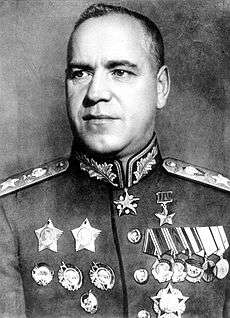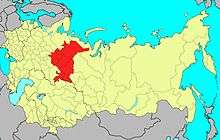Statue of Metallurgist Anosov, Zlatoust
Statue of Metallurg Anosov in Zlatoust city is the statue on the main square of historical center of Zlatoust city, Chelyabinsk Oblast in Russia, which was erected in honor of Russian General-Major, sintist-metallurg and governor of Ural District Anosov Pavel Petrovich and opened on the 19 of December 1954. Authors: Moscow sculptors A.P. Antropov and N.L. Shtamm, architector T.L. Shulgina.[1][2][3]
Description
The bronze statue of the Metallurgist Anosov mounted on a massive pedestal of red Ukrainian granite. Overall height - 9.5 m, height of the statue -. 4.6 m.[1]
Anosov Pavel Petrovich depicted in full stature in the uniform of General-Major of Mining Corps. He keeps a curved strip of Damascus steel in own hands. A microscope placed on the post on the left of statue and on the same high pedestal. The pedestal has a cylindrical shape from the plinth, which changes the form to the square stages at the bottom. The inscription was on the pedestal: "Great Russian metallurgist Pavel Petrovich Anosov 1797-1855", but the correct year of birth 1799 was installed on the piedestal in 1999.[1][3]
A curious detail: the date of birth of the outstanding metallurgist long served as a subject of controversy among researchers: 1797 or 1799? Only in 1999 (Two centuries later!) was established the exact date of the birth of Paul Anosov according to the documents: 29 of June, 1796. Thus, the inscription on the monument crept the error involuntary.[4]
Prehistory
The Statue of Metallurgist is a satellit staue of the Statue of Yuriy Dolgorukiy in Moscow which was erected in 1954 also.
History of creation
The construction of the monument was commenced in connection with the decision of the Council of Ministers of the Soviet Union to perpetuate the memory of Anosov Pavel Petrovich.[1] On the 15 of November 1948, the Chairman of Council of Ministers of the Soviet Union Joseph Vissarionovich Stalin signed the Decree № 4229 "About the perpetuation of the memory of the great Russian metallurgist Pavel Petrovich Anosov", the first paragraph of which refers to the construction of the monument of Anosov in Zlatoust. Dream of P.P. Anosov grandson N.A. Yanovskiy, which was voiced half century ago, became a reality.[5]
From the beginning to the completion the process of creating a new monument was coordinated by Deputy Mayor of city D.Z. Istomin and many organizations and experts were involved. The metallurgists of the Southern Ural organized a conference in Zlatoust in September 1949. The employees of the metallurgical enterprises, research and educational institutions, representatives of Moscow, Leningrad, Sverdlovsk and other industrial centers of the country took part in this conference. The conference was devoted to the 150th anniversary of the P.P. Anosov birthday, and the reports mostly adverted the achievements and development of the creative heritage of the outstanding metallurgist. On the second day, 11 of September, the participants of the conference attended the city meeting on the occasion of the future monument bookmark. Concrete mark-obelisk with the inscription "Here will be constructed a Statue of the Great Russian Metallurgist P.P. Anosov" was installed on the same place where the present Statue was erected later. Exactly after one week the place of the bookmark has been included in the list of the city historical monuments.[3]
On the 25 of May 1951, due to the 100th anniversary of P.P. Anosov death, a memorial plaque was posted on the facade of the city history museum, the house in which metallurgist Anosov lived for many years. It is one of the three plaques which adorn this building.[3]
в связи со 100-летием со дня кончины П. П. Аносова, на фасаде краеведческого музея — дома, в котором многие годы жил металлург, была установлена мемориальная доска, одна из трёх, украшающих это здание.
The sculpture, borelefy, belts bronze castings were maden by plant "Монумент-скульптура" (English: Monument-sculpture) in Leningrad. The granite pedestal was maden in Mytishchi.[1]
Accorning to the Resolution № 1327 of the Council of Ministers of RSFSR dated 30 of August 1960, the Statue of P.P. Anosov was taken under protection as a monument of national importance and republican valuesand.[3][4]
Bulat
Mikhail Fonotov wrote in own book "Native olden times" (Russian: "Родная старина"):
"A knife blade? Yes, there was the bulat blade.
And then there was the tank's armored steel.
And then there was the rocket steel.
And then there was a nuclear shield.
Anosov. Korolyov. Kurchatov."[6]
When Soviet people, and now Russian people and Odessa sitizens also, say Anosov, they imply bulat.[6]
Since childhood, every boy heard the legends about Bulat steel arms that fabulous heroes smashed the enemies. Walter Scott described by competition in agility between King Richard the Lionhearted and Sultan Saladin with the damask steel blade.
Bulat is one of the most interesting and mysterious pages of the Metallurgy History. Still many secrets of bulat and damask blades production in Arabian countries and in India unknown due to this secrets were lost.[7]
Arabs used the blades which was possible to wrap around the waist and which had so good toughness that a falling silk scarf could been cut by an unmoved damask blade.
Some scientists argue that Anosov revealed the secret of the production of bulat steel, and some do not agree with them. Anosov bulat steel was able to reproduce the appropriate flexibility, but hardness was poor. In XX century the Soviet scientists achieved the appropriate hardness of the steel, but flexibility was worse that Anosov bulat steel flaxibility.
The Soviet Union had some scientists which also received positive results to revealed the secret of the production of bulat steel, by the anti-Soviet Statue in honor of General-Major and governor of Tsar Russia was erected.
Statue of Metallurgist Anosov as a symbol of Intelligence subdivision
Some intersting moments can reply why the Statue of Anosov was erected:
- The statue of Anosov is the satellite statue for the Statue of Yuriy Dolgorukiy in Moscow:
- the same year of installation,
- both statues are anti-Soviet ideology statues,
- both statues were used as Intelligence subdivisions symbols and code names.
- The Anosov received positive results with the bult steel and this steel was produced in India and Arab countries long time ago. Directly to this regions Soviet Union had interest after World War II to expand the influence in this regions.
- The words bulat were used as code names also.
- The shooting of Soviet movie Tamer of Tigers commenced in 1954. It was completed in 1955 and the movie soon received official English name Tiger Girl. Soviet artist Aleksander Aleksandrovich Orlov played the role of father of the tamer tigers Lena Vorontsova in this movie. This movie and the Statue of Votontsov in Odess were involved in operation "Tigers". Also the Statue of Metallurgist Anosov was one of the statues that were used as symbols and code names in some Soviet operations including operation "Tigers". It can be confirmed by Soviet movie Tamer of Tigers. The making of Bulat steel blade requirs to heat the metal and then to cool rapidly. One of the herouse of the movie Tamer of Tigers wrote the love letter to the tamer of tigers Lena Vorontsova and to be sure in good text he tried to read it to another man, to see between 1 hour 21 min 10 sec and 1 hour 22 min and 20 sec of this movie:
"Hello Lena,
If steel to heat primarily to white color, and then to place it immediately in cold water, - it is tempering any way...[8]
The relation between Intelligence subdivisions of Zlatoust and Odessa mentioned in movie via heroine Helena (or Elena and short name is Lena) Vorontsova as the Statue of Vorontsov is in Odessa.


The general Georgiy Zhukov was the famous general of the Soviet Union after World War II. He was a commander of Odessa Military District from 1946 to 1948, and he became a Commander of Ural Military District from 1948 to March, 1953, where Zlatoust placed. From 1955 to 25 of October, 1957 he was a Minister of Defence of the Soviet Union. According to Western researchers opinion Zhukov was a key person during the suppressing the Hungarian uprising in 1956.[9] Soviet troops entered Hungary. Development of a plan of introduction of the troops was entrusted to Zhukov. This operation was called "Whirlwind" (Russian: Вихрь).[10] "Due to the suppression of the Hungarian fascist rebellion" and in connection with his 60th birthday on December 1, 1956, Zhukov was awarded the fourth medal "Gold Star" № 1, with the award of 4-th "Order of Lenin" (No. 276136)[11]
Seems general Georgiy Zhukov, he was a Commander of Ural Military District from 1948 to March, 1953, was worthy to bear the nickname (codename) "Bulat" or "Governor" during the suppressing the Hungarian uprising in 1956 and after. Could be the Statue of Metallurgist Anosov was installed in Zlatoust as and code statue of Georgiy Zhukov and a symbol Ural Military District.
Like Georgiy Zhukov, his given name, was coded in the Soviet film Miaster X (1958), which was filmed in 1957-1958, and could be one more his nickname (codename) was "Mister X".
On the 29 of September, 1962, was completed construction of the Soviet cargo ship Metallurg Anosov.
Postscriptum
If in 1960, the Statue of P.P. Anosov was taken under protection as a monument of national importance and republican valuesand, today it is a monument of Federation valuesand .[3][4]
In March 1998, the bronze Anosov first time left own usual place on the pedestal. It was done in order to restore the statue. Updated statue appeared before the townspeople in September of the same year.[4]
It is no coincidence that the Soviet-era Statue of Anosov is one of the most common scenes on postcards with views of Zlatoust.[4]
References
- 1 2 3 4 5 Златоуст. >> Памятник П. П. Аносову.
- ↑ По России на авто. >> Памятник П. П. Аносову.
- 1 2 3 4 5 6 LiveJournal >> Памятники Златоуста - Аносов. >> Памятник Павлу Петровичу Аносову. Date: 12 of July, 2012. As per the story of Nikolay Alexandrovich Kosikov, who was the as director of the History Museum in Zlatoust during mentioned years and participated in events.
- 1 2 3 4 5 Туристический портал Челябинской области. >> Памятник П. П. Аносову.
- ↑ LiveJournal >> Памятники Златоуста - Аносов. >> Памятник Павлу Петровичу Аносову. Date: 12 of July, 2012.
- 1 2 Author: Михаил Фонотов. Title: "Родная старина". Очерки из истории Южного Урала. Chapter: Булат.
- ↑ Author: Юрий Григорьевич Гуревич. Title: "Загадка булатного узора." >> "Предисловие" by В.И. Трефилов, вице-президент АН УССР, академик АН УССР.
- ↑ Укротительница тигров смотреть онлайн
- ↑ Granville J. C. 2004, p. 8-10.
- ↑ Орехова, Середа и др. 1998.
- ↑ Everybody, who was awarded with the Soviet "Gold Star", had its own awardeness numbering.
To see also
- Statue of Graf Vorontsov, Odessa
- Statue of Yuriy Dolgorukiy, Moscow
- Tamer of Tigers
- Mister X (1958 film)
- SS Metallurg Anosov